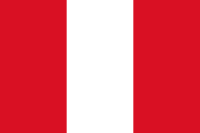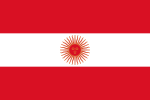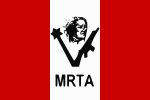Flag of Peru
| Flag of Peru | |
|---|---|
 |
|
| Vexillological symbol : |
|
| Aspect ratio: | 2: 3 |
| Officially accepted: | May 25, 1825 |
The flag of Peru was officially introduced on May 25, 1825.
Appearance and legal requirements
The bourgeois national flag consists of the colors red-white-red in typical republican (revolutionary) stripes (vertical) based on the model of the flag of France . The aspect ratio is 2: 3. All three stripes are the same width.
Regardless of whether it is a small hut or a large house, on the national holiday on July 28th, all buildings must be decorated with a national flag.
history
The probably first own Peruvian flag was hoisted by General Miller in Tacna on May 14, 1820. Contemporary records indicate that it was a blue flag with a sun representation in the center. On October 21, 1820, General José de San Martín in Pisco announced an ordinance describing the first official national flag : A silk or linen cloth divided diagonally into four fields should be used as the national flag. ... Two in red and two in white ... In the center, an oval-shaped laurel wreath is said to contain snow-covered mountains over a calm lake. A setting sun stands over the mountains .... The laurel wreath is green and fastened in the lower part with a gold-colored bow. The sky is blue, the sun is yellow with its rays, the mountains are dark brown and the sea is blue-green. Legend has it that San Martín landed on the coast of Paracas on September 8, 1820. Tired from the long journey, he fell asleep on the beach. When he awoke, he was blinded by the beauty of flamingos flying by . For San Martín, its outspread wings in the setting sun were the inspiration for Peru's first red and white flag. There are no contemporary images of the coat of arms, so that one has to rely on the general description for the reconstruction.
On March 15, 1822, the “Chief Delegate”, José Bernardo de Tagle Portocarrero, ordered a modification of the flag: from now on it should consist of 3 horizontal stripes, one white between two red ones. In the center there should be a representation of the sun. In the reconstruction, the sun is usually depicted entirely red or golden with a red ring. However, it is known that in South America at these times the sun was mostly given human features. Furthermore, in a museum in Lima, Peru, there are old originals or reproductions of the flag that show the sun as golden with human features. However, there are also older images of flags and coats of arms that "simply" depict the sun. Another change to the flag design was carried out in 1823 (possibly even in the middle of 1822) when the arrangement of the stripes was changed from a horizontal to a vertical position. This was probably due to the fact that the flag was otherwise too similar to the Spanish one , which had horizontal red stripes with a yellow central stripe. The official order of this change, however, only happened on February 25, 1825 during a constituent assembly of the Peruvian parliament chaired by Simón Bolívar . Among the five new proposals submitted for a national flag, none was approved by Bolívar. Finally, the previous flag was retained, but the sun in the center was replaced by the national coat of arms.
Flags of the Peruvian-Bolivian Confederation
From 1836 to 1839 Peru was part of the Peruvian-Bolivian Confederation , which the Bolivian dictator Andrés Santa Cruz established after an invasion of Peru. Peru was divided into two states: Northern Peru and Southern Peru . While the state of northern Peru continued to use the national flag established in 1825, a new flag was created for southern Peru. This was set on March 20, 1836 by delegates from the southern provinces in Sicuani . It consisted of a vertical red stripe on the flagpole and a green over a white stripe on the flying end. Since southern Peru consisted of the four provinces of Arequipa , Puno , Cuzco and Ayacucho , four gold-colored stars were placed in a semicircle over a shining "Inca sun". This arrangement also represented the state coat of arms of South Peru. The flag of South Peru was abolished with the end of the Confederation in 1839. In 1838 a special confederation flag was created, which consisted of a red cloth. On this was the coats of arms of the member states, which were framed by a garland of branches.
In 1950 General Odría designated the flag without a coat of arms as the new civil and commercial flag.
Flag anthem
Marcha de Banderas - Flag march
- Arriba, arriba, arriba el Perú y su enseña gloriosa inmortal,
- llevad en alto siempre la bandera nacional.
- Valley la llevaron con gloria y honor, heroes peruanos de invencible ardor.
- Arriba, arriba siempre la bandera nacional.
- Es la bandera del Perú,
- de rojo y blanco color, cual llamarada de amor,
freely translated:
- High be Peru and its glorious, immortal flag! always carry the national flag high.
- So they carried the heroes of Peru with glory, honor, and with insurmountable fervor; High! the national flag is always high!
- It is the flag of Peru - red and white, like the torches of love;
State and war flag
The emblem of the state and war flag , which is in the middle white area, shows the three riches of the country in three fields: flora (quina tree), fauna (vicuña) and minerals (cornucopia). The emblem of the official flag is framed on both sides with a palm and a laurel branch. A closed wreath is depicted above the coat of arms. The wreath is also found on the land of war flag . On the side there are four Peruvian flags. The naval war flag corresponds to the service flag. The different branches of the armed forces of Peru have their own flags.
Subnational flags
Main article: Flags and coats of arms of the departments of Peru
Peru is divided into 24 regions ( departments ), which in turn are divided into provinces. These administrative units and also the cities have their own flags. ( see also: Administrative division of Peru )
There are also versions of the flags with coats of arms that do not carry the coat of arms. Here are some examples:
2: 3 Lima Province
3: 5 Arequipa Province , Arequipa region
2: 3 Ayabaca Province , Piura Region
2: 3 Chimbote (city), Ancash region
2: 3 Huánuco region
2: 3 Region Puno
3: 5 Tumbes region
Political flags
In the second half of the 20th century, two guerrilla movements fought against the government in Lima . The "Shining Path" ( Sendero Luminoso ) was a Maoist movement whose communist convictions were also reflected in its flag. The Movimiento Revolucionario Túpac Amaru showed the head of its role model Túpac Amaru , an Indian fighter against the Spanish colonial rulers , on the Peruvian flag . There is also a machine gun and a star on a pole that form a V for "Victory".
The left-wing Alianza Popular Revolucionaria Americana (APRA) is Peru's oldest surviving party. She also uses the revolutionary red in her flag.
Individual evidence
literature
- Smith / Neubecker: Coats of arms and flags of all nations , Munich 1981, ISBN 3-87045-183-1






















